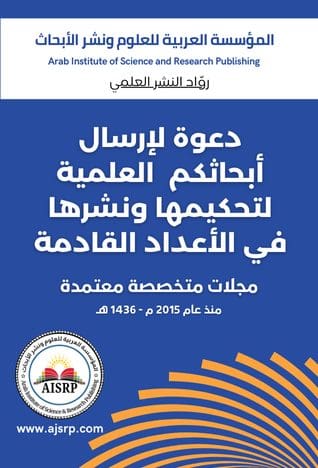Methods of media war in terrorist organizations and mechanisms used to address them Analytical theory study on the so-called “Islamic State Organization”
Abstract:
The purpose of this research is to study media war and how it is used by terrorist organizations by defining the conditions of its establishment, highlighting its mechanisms and analyzing its most important features among terrorist organizations in general and the so-called ‘Organization of the Islamic State’ in particular.
The reason for this concern is the growing importance of the media war and the fundamental and pivotal role played by traditional and modern media, or the so-called new media and social networking sites (Twitter, Facebook, YouTube. . . ) in attracting the Mujahideen and spreading their ideas and beliefs and resorting to these means to coordinate criminal operations committed by terrorist organisations within the hotbeds of tension, as well as within peaceful countries.
In order to conduct a rigorous scientific analysis of communication and media strategy used by the so-called ‘Organization of the Islamic State’ and to study ways and means of its embodiment as well as propaganda content disseminated and published by this organization, we used the analytical descriptive method, which descripes “what exists” with respect to situational variable , and adopted quantitative and qualitative analysis mechanisms and tools.
After explaining and analyzing the components and tools of the adopted communication and media strategy , we find that the so-called “Organization of the Islamic State” completely controls the communication process and mixes between traditional and modern means of communication and media and uses the symbolism at the level of form and content through the selection of dates and the use of religious references to justify criminal acts and to give evidence on credibility.
Our research concluded that addressing the communication and media war waged by terrorist organizations in general and the so-called “Organization of the Islamic State” in particular requires tightening controls on the means of communication, media and suspicious social networking sites and intensifying international communication and media cooperation especially with countries affected by terrorist crimes , as well as organizing awareness campaigns on the dangers of the terrorist media contents aimed at young men and children and the inclusion of the “Media Education” course as a compulsory subject in schools and secondary institutes to prepare a generation capable of dealing positively and intelligently with traditional and particularly modern media.
Keywords:Media War – Communication and media strategy – Terrorist organizations – Organization of the Islamic State.
الملخص
وما جعلنا نهتم بالبحث في هذا الموضوع هو تزايد أهمية الحرب الإعلامية والدور الأساسي والمحوري الذي صارت تلعبه وسائل الاتصال والإعلام التقليدية وخاصة الحديثة وما يسمى بالإعلام الجديد ومواقع التواصل الاجتماعي في الحروب والنزاعات واستخدامها المتزايد من قبل المنظّمات الإرهابيّة لاستقطاب “المجاهدين” وبث أفكارهم التكفيريّة ومعتقداتهم و تنسيق العمليّات الاجرامية التي يقومون بها في شتى دول العالم.
وحتّى نتمكّن من تحليل الاستراتيجية الاتصالية والإعلامية لما يسمى بـ”تنظيم الدولة الاسلامية” تحليلا علميّا دقيقا ودراسة سبل وأساليب تجسيدها والوسائل والمضامين الدعائيّة التي يبثّها وينشرها توخّينا المنهج الوصفي التحليلي، “الذي يعتمد على دراسة الظاهرة كما توجد في الواقع ويهتم بوصفها وصفا دقيقا” واعتمدنا آليات وأدوات التحليل الكمّي وكذلك الكيفي.
بعد شرح وتحليل مكوّنات وأدوات الاستراتيجية الاتصالية والإعلامية ” المتّبعة تبيّن لنا أن ما يسمى بـ”تنظيم الدولة الاسلامية” يتحكّم كلّيا في العمليّة الاتصالية ويمزج بين الوسائل الاتصالية الإعلامية التقليدية والوسائل الحديثة ويستعمل الرمزية على مستوى الشكل والمضمون من خلال اختيار التواريخ واستخدام المرجعيات الدينية لتبرير أعماله الإجرامية وإضفاء نوعٍ من المصداقية عليها. . .
وخلص بحثنا إلى أن التصدي للحرب الاتصاليّة والإعلاميّة التي تشنّها المنظمات الإرهابية عامّة وما يسمى بـ”تنظيم الدولة الاسلامية” خاصّة يتطلّب تشديد الرقابة على وسائل الاتصال والإعلام ومواقع التواصل الاجتماعي المشبوهة وتكثيف التعاون الاتصالي والإعلامي الدولي خاصّة مع الدول التي تضرّرت من الجرائم الإرهابية وتنظيم حملات توعويّة حول مخاطر المضامين الإعلامية الإرهابيّة الموجّهة للشبّان والأطفال وإدراج “التربية على وسائل الاتصال والإعلام” كمادّة دراسيّة إجباريّة في المدارس والمعاهد الثانويّة حتّى نهيّئ جيلا قادرا على التعامل بإيجابيّة وذكاء مع وسائل الاتصال والإعلام التقليديّة وبالخصوص الحديثة.
الكلمات المفتاحية: الحرب الإعلامية – الاستراتيجية الاتصالية والإعلامية – المنظمات الإرهابية – تنظيم الدولة الاسلامية.
الباحث /
لطفي محمد الزيادي
قسم الاتصال والإعلام || كليّة الآداب جامعة الملك فيصل || المملكة العربية السعودية



